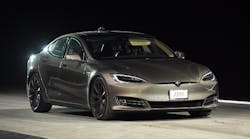Tesla Will Have a Tough Time Ramping up Production. Here's Why
Ramping up an auto manufacturing line is difficult. For a newcomer, reaching efficient and lean operation at the level of Toyota and GM is extremely challenging. And, as I pointed out in the past, Tesla’s ongoing manufacturing woes are a painful proof.
In 2010, Tesla acquired the Fremont, California, NUMMI manufacturing plant previously owned jointly by General Motors and Toyota, for a $42 million bargain-basement deal. When I visited the Fremont plant a while ago, my host was especially proud of the junkyard price the company paid for two huge Schuler hydraulic stamping presses, which form the largest line in North America, and the 6th largest in the world.
What Tesla didn’t get as part of the deal is knowledge and experience in complex manufacturing.
Too Many Employees
According to a recent article in The Wall Street Journal, finding a parking spot at the Tesla factory is a daunting task. Every day, 6,000 employees compete for just 4,500 parking spots. Vehicles are crammed into every nook and cranny of the lot, some parked illegally, others crammed so close that the car’s doors can’t be opened.
There are stories of parking lot feuds, and of employees making deals with workers on other shifts to hold parking spaces for them. The situation is so bad that someone launched an Instagram page to capture the craziness employees face every day.
The problem seems to be a result of Tesla’s success. The company has increased its overall workforce over the last two years to 17,000 in order to reduce lingering delays in delivering Model S to customers, and to ramp up the manufacturing of the Model 3. Facing a growing backlog of over 400,000 units, Tesla reportedly is planning to reach a production rate of 5,000 vehicles per week by the end of the year.
But the NUMMI plant and its parking facilities were designed to support such a high vehicle production rate. When operated by Toyota and GM, it built an average of 6,000 vehicles a week, producing, in 2005, more that 400,000. And it did it with fewer than 5,000 line workers in two shifts. On an ongoing basis, NUMMI’s production rate averaged about 75 vehicles per worker per year.
In contrast, Tesla’s total 2016 production was 83,922 vehicles, or productivity rate of about 14 vehicles per worker per year—less than 20% of the productivity of GM or Toyota. While the total output shows a significant increase of 65% from 2015, this improvement was achieved primarily by a massive increase in manpower. Catching up with the backlog is going to be very challenging.
What’s the reason for the huge discrepancy in productivity? Toyota is master of lean manufacturing and effective quality management. During the 25-year joint venture with Toyota, GM had adopted and perfected lean manufacturing, and, in particular, just-in-time inventory and supplier management. Other global OEMs did the same. But during my visit to the Fremont factory, the Schuler presses were idle, and stamped panels were stacked high by their side …
Tesla’s approach to manufacturing suffers from a Silicon Valley mentality that favors vertical integration and believes that smarts trumps experience. The company started 2017 with its best-ever quarterly vehicle production rate, but Elon Musk’s goal of quintupling production output to a half million units by 2018 doesn’t seem achievable.
Too Many Complaints (But Many More Loyal Owners)
Tesla’s loyal customers do not complain much about their prized possession. But blogs and web user groups reveal an increasing number of issues, many having to do with quality control of interior fit and finish. Consumer Reports, that in 2015 gave the Model S the highest-ever score, breaking the Consumer Reports Ratings system, reported recently that after 20 months and over 15,000 miles, the test car has had more than its fair share of problems. Eventually, Consumer Reports downgraded the Model S To ‘Below Average’ reliability.
Tesla appears to be struggling with fundamental quality control issues and manufacturing tolerances that aren’t as tight as consumers expect from luxury cars.
Tesla cars received praises for its many software-control features and the ability to fix software defects and provide upgrades via automatic remote software updates. But mechanical problem and manufacturing defects, such as the brake issue that resulted in a voluntary recall of 53,000 cars earlier this year, exposed adhesive on roof liners, out-of-alignment trunk latches, or sunroof leaks still require a visit to the repair shop.
Of course, Tesla earned a reputation for the valet customer service. But the growing number of Tesla cars and problems that cannot be repaired via software patches, coupled with the limited capacity of service centers are causing service delays.
As Consumer Reports likes to point out, consumers can be loyal to less reliable cars. Indeed, service delays haven’t had a major effect on the Tesla brand because early owners are often quite forgiving and many of them do not rely solely on their Tesla for daily transportation needs anyway.
Too Many Injuries
Back to the Fremont factory.
A recent report from California-based Worksafe claims Tesla’s injury and illness rates are significantly higher than the average for the industry. In a report titled Analysis of Tesla Injury Rates: 2014 to 2017, Worksafe notes: “Even though the process of assembling a car has become more technologically advanced, work in an auto plant remains a physically challenging job that carries a higher-than-normal risk of injury.”
In response, Tesla’s blog Creating the Safest Car Factory in the World begins with blaming the United Automobile Workers (UAW) for spreading allegations about safety problems in the Tesla manufacturing plant.
The blog then continues to describe several safety-related improvements the company is implementing, including the creation of departmental Safety Teams, reducing overtime, and conducting ergonomic studies to improve assembly equipment and process.
These are long-standing, carefully-followed practices at any established assembly manufacturing plant, but they were not bundled in the NUMMI factory deal.
Making Cars is Hard to Do
Indeed, becoming a world-class volume car manufacturer is not easy. Decades of perfecting supply chains and manufacturing methods, and sweating the smallest details, all those intangible assets that Tesla did not inherit with the NUMMI factory, are critical. And even the ever-optimistic Tesla is finally acknowledging in a recent blog article addressing safety breeches: “The difficulty of starting a successful U.S. car company cannot be overstated.”
Are these challenges insurmountable? Probably not. But Tesla needs to address them at the root, and soon, as throwing more people at the problem will not be enough to handle the backlog of the much-anticipated Model 3, which is critical to Tesla’s business, especially facing competition from the new Nissan Leaf and Chevy Bolt electric vehicles.
One answer, or at least part of it, might be for Tesla to develop a relationship with contract manufacturer Magna Steyr, whose parent company’s stock has lost much value since 2016 and is said to be under pressure from investors. And if Tesla believes the rumors, then this might also be a good move to block Google’s autonomous car manufacturing plans.
Joe Barkai is a consultant, speaker, author and blogger, charting market strategies for a connected world: Internet of Things, connected cars, innovation and product lifecycle.




